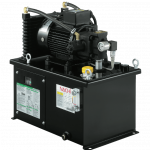5 Examples of Pneumatic Systems From Everyday Life
Pneumatic systems use pressurized gases (as opposed to hydraulics which use liquids). While people sometimes associate hydraulic and pneumatic systems with big, complicated machines in factories, there are actually many examples from everyday life.
This blog post gives five examples of pneumatics, some of which you’ve probably used. Also, click here to read about “6 Things You Didn’t Know Used Hydraulic Systems.”
Bicycle Pumps
These pumps are used to inflate bicycle wheels, basketballs, footballs, etc., but have you ever wondered how they actually work? They’re very simple machines, but they illustrate some important principles of pneumatics.
One important thing to remember about pneumatic systems is that air flows from high pressure to low pressure. A good way to think about this is to imagine a bunch of billiard balls moving about. The billiard balls will hit each other and bounce off, spreading out, naturally defusing. Just like these billiard balls, air molecules will bump into each other and spread out, moving from high pressure to low pressure.
Another important detail is that when you decrease the volume of a container full of air, the pressure will go up. (Imagine pushing all the billiard balls together. The less room they have, the more they will bounce off each other and off the walls of their container.)
Bicycle pumps have chambers full of air inside them. When you press down on the handle of the bike pump, you decrease the volume of the chamber inside, increasing the pressure. Since air flows from high pressure to low pressure, the air will then flow out of the higher pressure of the chamber and into the tire through the nozzle.
Then, when you raise the handle, you decrease the pressure in the camber, causing air to rush in from the outside. Normally, air would flow backwards from the tire into the chamber as the pressure in the chamber decreased, however, bike pumps have a valve that only lets air flow one way.
Learn more details by watching this video. It will help you visualize what’s happening.
Brakes on Buses and Trucks
While hydraulic brakes are usually used for smaller vehicles, large trucks and buses most often have pneumatic air brakes. The main advantage is that when hydraulic brakes fail, the car will be unable to stop, but when air brakes fail, the truck will stop automatically. This gives air brakes a safety advantage as well as being more powerful. On the other hand, hydraulic brakes are smaller and don’t take up as much room.
Need hydraulic or pneumatic systems for your business? Call us today.
Tire Pressure Gauges
When you use a tire pressure gauge (one of those little metal cylinders that check how full of air your tire is), air from the tire goes into the gauge which is hollow in the top part.
Now there’s a small piston inside the gauge that’s attached to a spring underneath it. The air from the tire presses on the piston pushing it down and compressing the spring. This causes the scale with the pressure measurement to come out. The spring is what keeps the scale from shooting all the way out.
Jackhammer
Yes, it seems strange, but we use air to break concrete. Compressed air is forced into the Jackhammer, pushing down a pile driver into the bit (the metal piece that comes out and actually breaks the concrete apart). Jackhammers are an amazing (and dangerous) example of what simple air can do.
Pneumatic Nail Guns
There are different types of nail guns, but pneumatic guns are popular. They use air to push nails out at high speeds, embedding them into wood.
There are a lot of other pneumatic devices besides these, some of which we’ve covered in other articles, such as the lap bars at amusement parks and the door closers that keep your door from slamming shut (which can use either hydraulics or pneumatics).
If you want excellent hydraulic and pneumatic equipment for your company, or if you want your pneumatic machine repaired, call Air & Hydraulic Equipment, Inc. We’ve been in business for over 50 years and have five locations in Tennessee—Nashville, Chattanooga, Cookeville, Knoxville, and Bristol.










